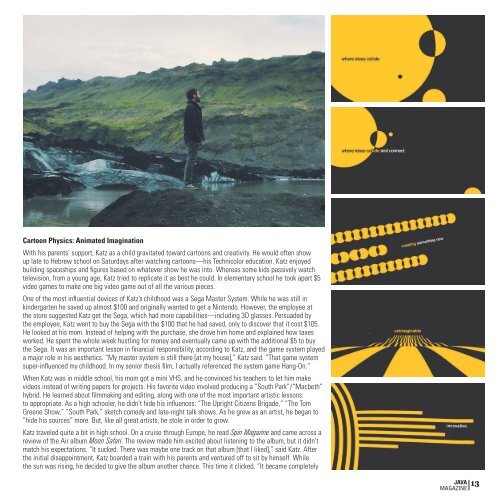Java.FEB.2017
Create successful ePaper yourself
Turn your PDF publications into a flip-book with our unique Google optimized e-Paper software.
Cartoon Physics: Animated Imagination<br />
With his parents’ support, Katz as a child gravitated toward cartoons and creativity. He would often show<br />
up late to Hebrew school on Saturdays after watching cartoons—his Technicolor education. Katz enjoyed<br />
building spaceships and figures based on whatever show he was into. Whereas some kids passively watch<br />
television, from a young age, Katz tried to replicate it as best he could. In elementary school he took apart $5<br />
video games to make one big video game out of all the various pieces.<br />
One of the most influential devices of Katz’s childhood was a Sega Master System. While he was still in<br />
kindergarten he saved up almost $100 and originally wanted to get a Nintendo. However, the employee at<br />
the store suggested Katz get the Sega, which had more capabilities—including 3D glasses. Persuaded by<br />
the employee, Katz went to buy the Sega with the $100 that he had saved, only to discover that it cost $105.<br />
He looked at his mom. Instead of helping with the purchase, she drove him home and explained how taxes<br />
worked. He spent the whole week hustling for money and eventually came up with the additional $5 to buy<br />
the Sega. It was an important lesson in financial responsibility, according to Katz, and the game system played<br />
a major role in his aesthetics. “My master system is still there [at my house],” Katz said. “That game system<br />
super-influenced my childhood. In my senior thesis film, I actually referenced the system game Hang-On.”<br />
When Katz was in middle school, his mom got a mini VHS, and he convinced his teachers to let him make<br />
videos instead of writing papers for projects. His favorite video involved producing a “South Park”/“Macbeth”<br />
hybrid. He learned about filmmaking and editing, along with one of the most important artistic lessons:<br />
to appropriate. As a high schooler, he didn’t hide his influences: “The Upright Citizens Brigade,” “The Tom<br />
Greene Show,” “South Park,” sketch comedy and late-night talk shows. As he grew as an artist, he began to<br />
“hide his sources” more. But, like all great artists, he stole in order to grow.<br />
Katz traveled quite a bit in high school. On a cruise through Europe, he read Spin Magazine and came across a<br />
review of the Air album Moon Safari. The review made him excited about listening to the album, but it didn’t<br />
match his expectations. “It sucked. There was maybe one track on that album [that I liked],” said Katz. After<br />
the initial disappointment, Katz boarded a train with his parents and ventured off to sit by himself. While<br />
the sun was rising, he decided to give the album another chance. This time it clicked. “It became completely<br />
JAVA 13<br />
MAGAZINE


















